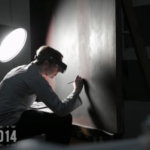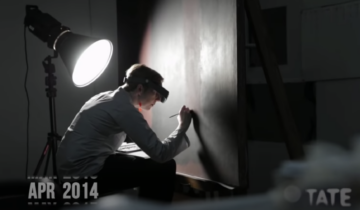

“The people who weep before my pictures are having the same religious experience I had when I painted them. And if you, as you say, are moved only by their color relationship, then you miss the point.” — Mark Rothko
In 2012, a Russian artist calling himself Vladimir Umanets wrote his name and the words “A potential piece of yellowism” in black marker on the corner of Mark Rothko’s 1958 canvas Black on Maroon. The damage to the painting, housed at the Tate Modern since 1970, was substantial, and it turned out to be one of the museum’s most challenging restoration projects, as well as one of its most successful — “far more successful than any of us dared hope,” said Tate director Nicholas Serota. The painting went back on display in May of 2014.
Due to Rothko’s layered technique, the painting’s “surface is really delicate and it turned out that most of the solvent systems that could dissolve and remove the ink could potentially damage the painting as well.” Patricia Smithen, the Tate’s head of conservation, told The Guardian. The video above from the museum shows the art and science that went into restoring the famous work, an eighteen-month-long process that involved some reverse engineering from a canvas donated by the Rothko family.
Black on Maroon seemed like an odd choice for a protest, as a blogger at Art History Abroad wrote the following day: “‘Why Rothko?’. His paintings [are] often criticised by those who don’t favour their abstraction, but rarely deemed politically or socially motivated to a point that they might provoke vandalism.” The presence of Black on Maroon and other Seagram Murals at the Tate, in fact, mark an act of protest by Rothko himself (who committed suicide the day the paintings arrived at the London museum).
The Seagram Murals were originally commissioned for the Four Seasons restaurant in the Seagram building in New York, designed by Mies van der Rohe and Philip Johnson. Seven paintings were commissioned, Rothko made 30. He reportedly told Harper’s editor John Fischer he wanted to create “something that will ruin the appetite of every son-of-a-bitch who ever eats in that room.” When he finally got the chance to dine at the completed restaurant, he was disgusted, withdrew his work, and returned his commission, writing, “it seemed clear to me at once that the two were not for each other.” He spent the next decade thinking about how and where to display the paintings.
Umanets did not seem to care much about the history of the murals in the Tate’s Rothko Room and claims his choice had no meaning. “I didn’t single out Rothko to make my statement,” he wrote in a public letter of apology published after he spent a year and a half in prison. “I would have done the same had the artist been Damien Hirst or Tracey Emin. It was a spontaneous decision and nothing personal.” Likewise, his Dada-esqe “Manifesto of Yellowism” outlines a program with a distinct lack of concern for specificity and a vaguely satirical desire to flatten art into one color, one purpose, one meaning.
Even as he publicly abjured his act of protest (maybe by order of the court?), Umanets also expressed a genuine concern for the future of art, “Art has become a business, which appears to serve only the needs of the art market. As a result the art world no longer has radical thinkers and polemicists willing to scythe new and different pathways. Everyone is playing safe.” He might have made his point more clearly by going after Jeff Koons. Rothko was a radical thinker, and his Seagram Murals represent a final refusal to compromise with the demands of the art market.
Related Content:
A Short Documentary on Artist Jeff Koons, Narrated by Scarlett Johansson
Watch an Art Conservator Bring Classic Paintings Back to Life in Intriguingly Narrated Videos
The MoMA Teaches You How to Paint Like Pollock, Rothko, de Kooning & Other Abstract Painters
Josh Jones is a writer and musician based in Durham, NC. Follow him at @jdmagness
Watch the Tate Modern Restore Mark Rothko’s Vandalized Painting, <I>Black on Maroon</I>: 18 Months of Work Condensed Into 17 Minutes is a post from: Open Culture. Follow us on Facebook and Twitter, or get our Daily Email. And don't miss our big collections of Free Online Courses, Free Online Movies, Free eBooks, Free Audio Books, Free Foreign Language Lessons, and MOOCs.

0 Commentaires